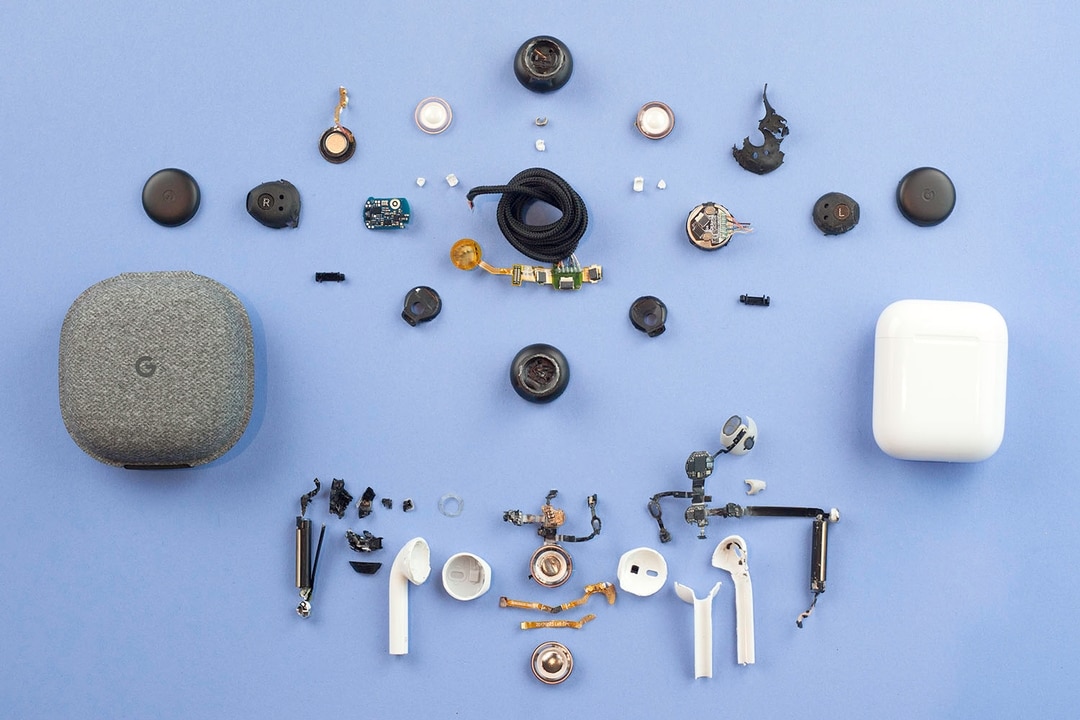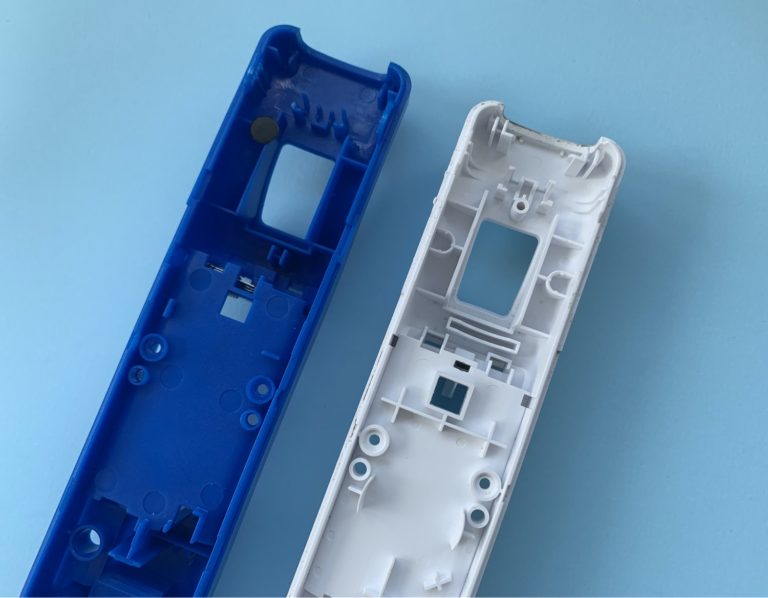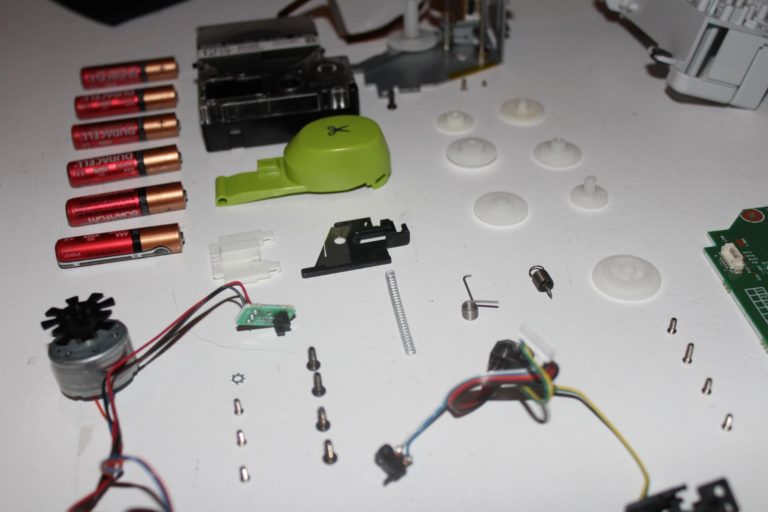You can learn a lot from examining the ways in which different companies solve the same problem. After stripping the one-eighth-inch audio jack out of their phones, Apple and Google both needed to create a set of Bluetooth headphones, but each company took a very different approach to the solution.
Apple crafted their AirPods to closely resemble their iconic corded earbuds, which required careful design to fit everything into such a small form factor. Google took a more novel approach to their Pixel Buds, by connecting the two sides with a cloth-covered cord that doubles as adjustable ear fins. We teamed up with our friends at Mindtribe to get a better understanding of how these two different approaches to electrical and mechanical design compare, you can find Mindtribe’s write-up on the electronics here.
Here are the features of interest we’re drilling into for this head-to-head teardown:
1. Human Factors – how ergonomics and usability are considered in each design
2. Assembly – how the headphones are put together
3. Packing – how each design makes the most out of the available space
For our new readers, Fictiv is a virtual manufacturing company that combines state-of-the-art software, a global network of pre-qualified manufacturing partners, and a dedicated team of service experts to transform how teams design, develop, and deliver the next generation of physical products.
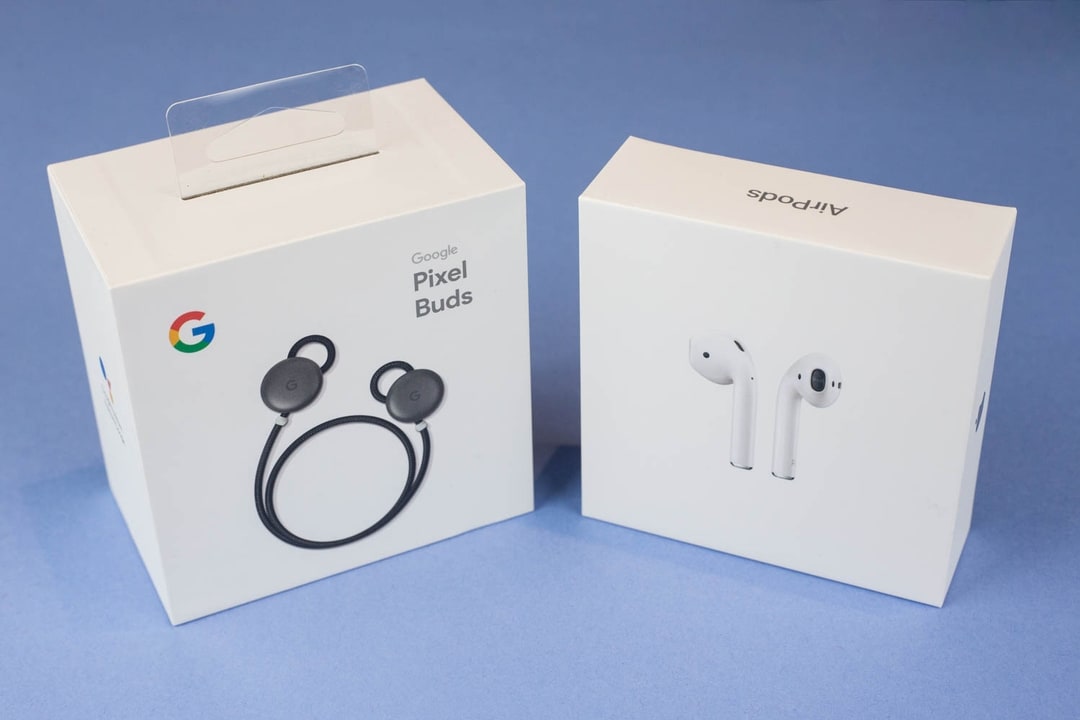
Human Factors
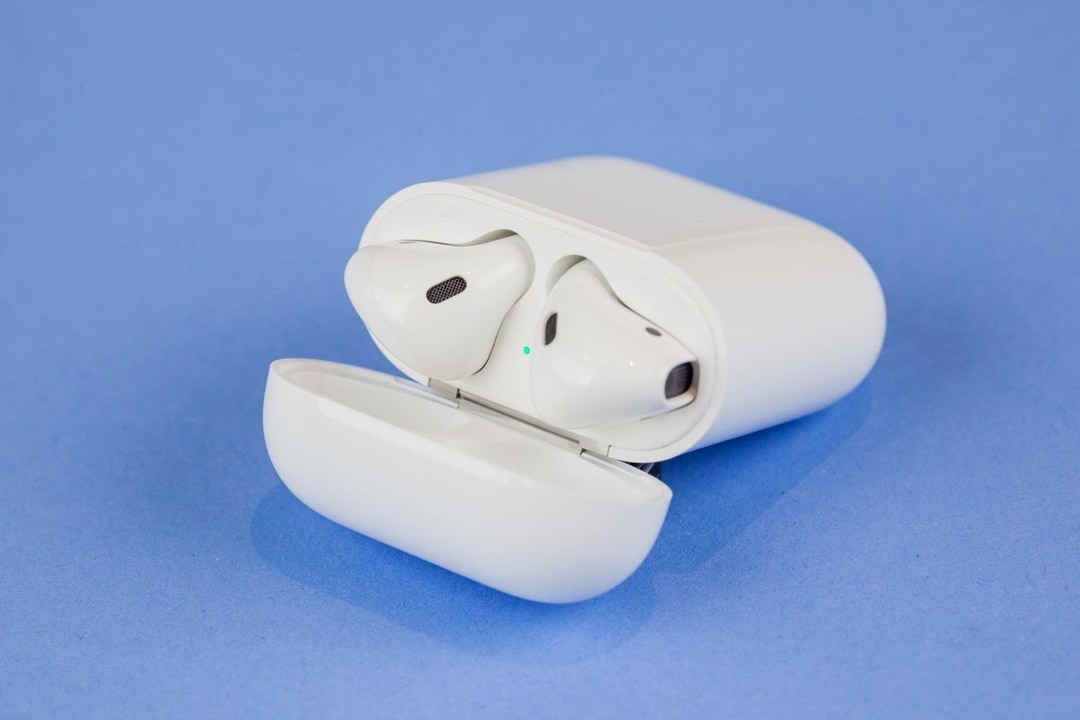
Like most Apple products, the AirPods look sleek and simple. A small “L” and “R” indicate the left and right pod, but they’re not really necessary, as the stems clearly indicate which side of the pod faces down and thus how they should be worn. While Google used cloth to give the Pixel Buds a clothing-like feel, the shiny white and chrome on the Airpods plays to a different set of emotions, inviting the user to wear them like a piece of jewelry.
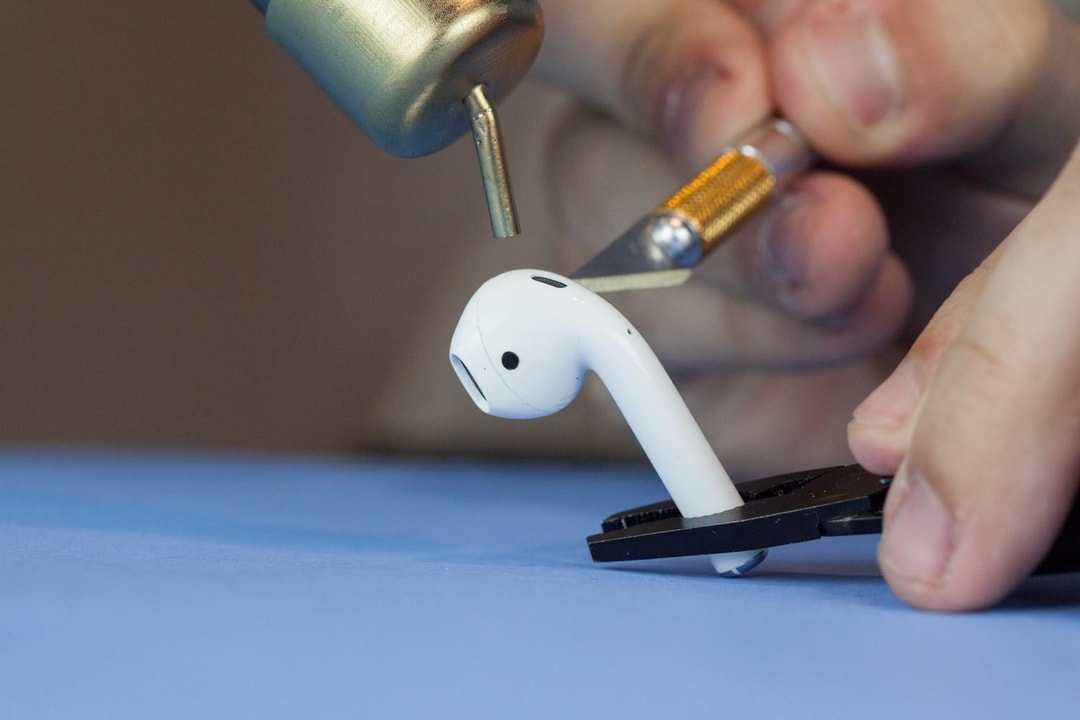
When the AirPods were first announced, there was some concern about them falling out of people’s ears, which, at first glance, seems like a well-founded concern. The entire surface of the pods is hard, glossy plastic, with none of the grippy rubber usually found on headphones. However, they are designed to fit in the ear so well that there have been few issues with their stability or comfort. This quite literal application of design for human factors means the pods will stay in place, even through strenuous physical activity.

The cord connecting the two Pixel Buds passes through a molded hole in the casing, making a little loop on the top of each bud. In addition to holding both buds around your neck, the cord acts as the fins that hold the buds in your ear and allows them to be adjusted to fit any ear size. Each end of the cord has a small white bead affixed to it that prevents it from being pulled through too far.

The inner ear part of the pixel buds is comfortable, with a soft rubber overmolding. This rubber provides much more grip and softness than hard plastic would have, meaning that even if the cord is pulled all the way, so that no fins stick out, the buds will still stay in your ear.
Assembly
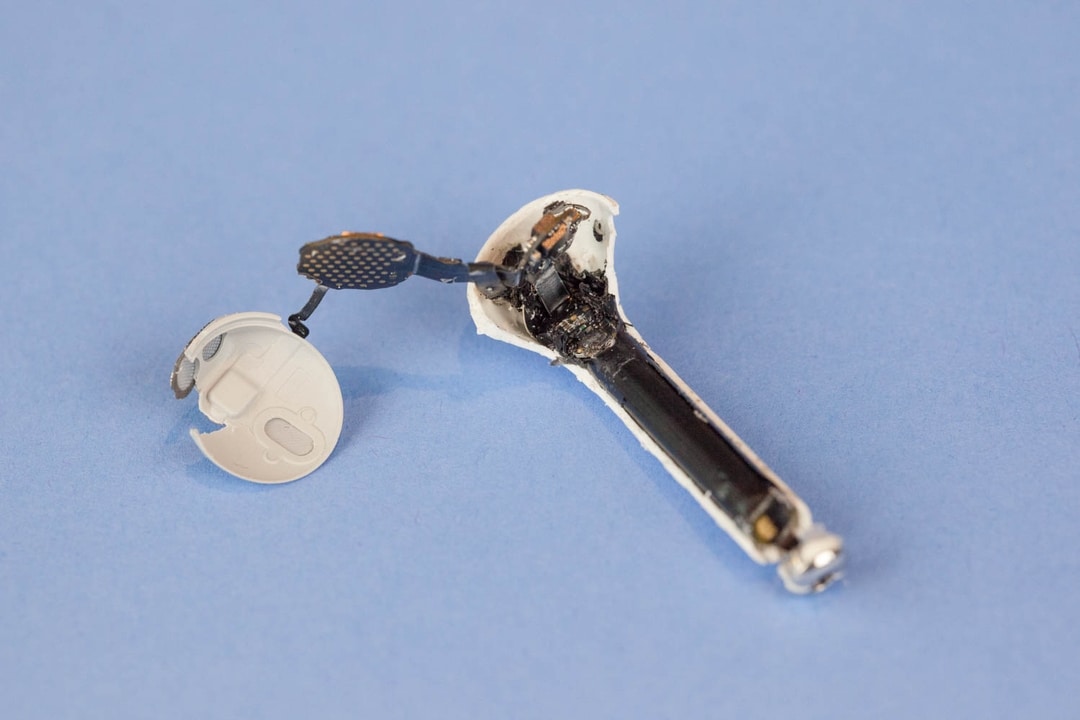
The assembly was done with adhesives, so disassembly was facilitated with a heat gun. Right away, we found the glue holding the lip and groove joint between the two pieces of the outer casing to be tougher than that in the Pixel Buds. It took several passes with a heat gun and hobby knife to separate the two parts. The glue we found where the upper portion of the pod meets the stem was even tougher, and required us to cut the casing of one of the pods in half to get at it. Once inside, we found there wasn’t just glue, but rubber that had been injected to secure and insulate the top of the battery.

Due to the compact shape of the AirPods, the battery and PCBs need to be inserted from different ends of the main casing, and then connected electrically. It appears this is accomplished by first inserting the PCB assembly from the ear side of the casing, feeding the long flex cable through the stem. Then an assembly containing the battery, the bluetooth antenna, and a flex cable connected to the positive and negative terminals of the battery is inserted up through the base of the stem. Once in place, the flex from the PCBs is spot welded to the end of the flex on the battery, while the antenna is attached via a tiny coaxial button connector.
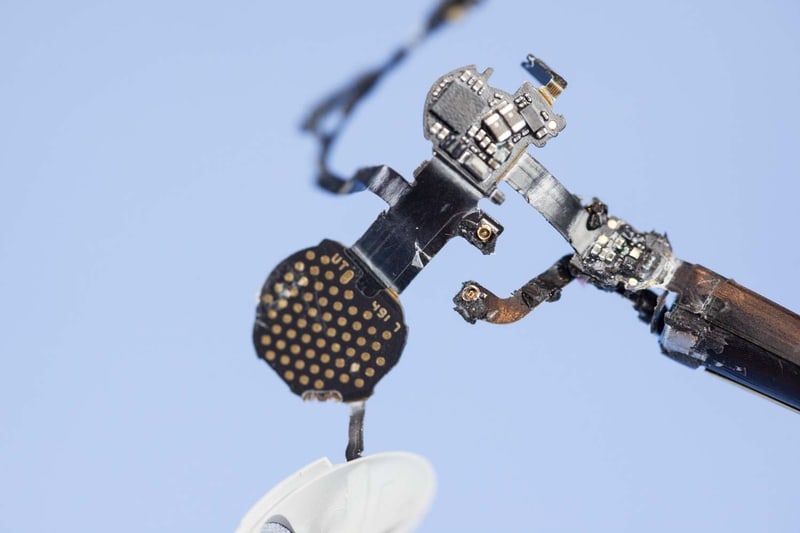
To aid assembly, the main PCB is located by two pins, which are then heat staked down to hold the board to two shelves, which are glued to the inside of the casing. A flex cable then acts as a hinge, allowing the inner ear portion to be assembled, before finally folding over and gluing the two parts together.
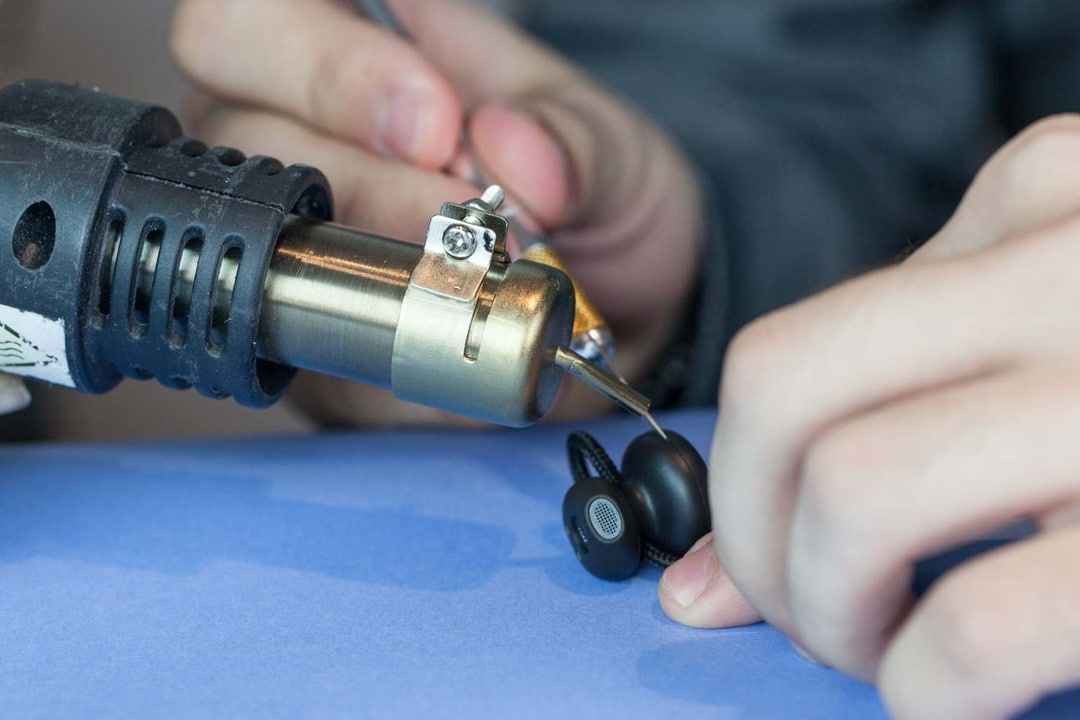
The Pixel Buds are small enough that there is no room for any type of mechanical fasteners, so most of the components are held in place by glue. The glue in the Pixel Buds softened easily with a heat gun, but given that all the major structural components were plastic, we had to be careful not to melt them (or at least not melt them too much).
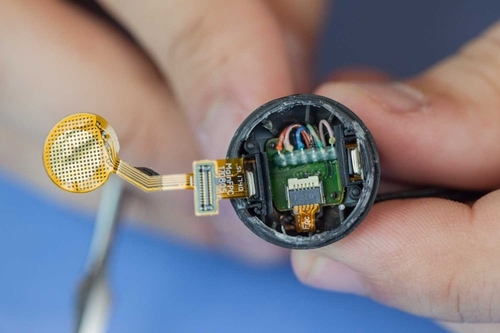
Lip and groove joints are glued together to connect the main body of the buds to the inner and outer ear parts. Inside the buds, a couple of heat staked pins are used to hold the PCBs in place. Interestingly, there are two plastic brackets that support the external microphones, which are held by heat staked pins on one side and then clipped on the other. This dual connection method prevents the brackets from being over constrained and also allows them to pivot, which no doubt helps ease assembly.
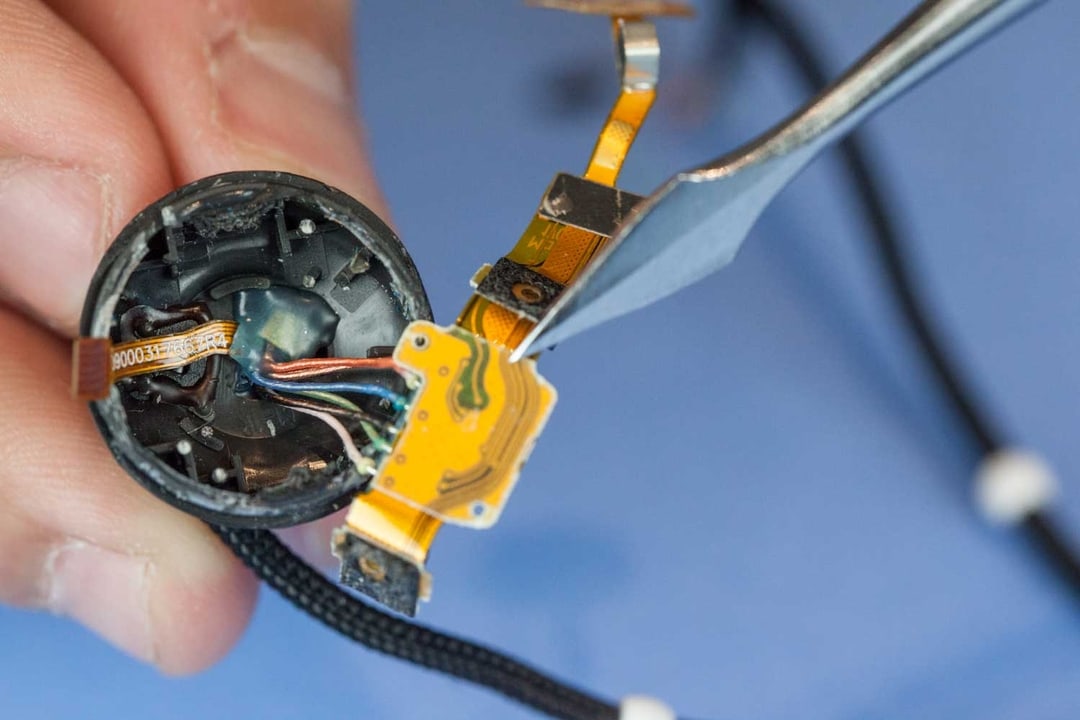
The cable that connects the left and right bud feeds through a channel that runs through the central injection molded part, where it is glued in place. While the way the cable twists and loops through the bud to create the fins means that the brunt of any sharp force on the cable would be supported by the friction of the cable wrapping around the bud, a healthy (read: difficult remove) amount of glue is used to make sure the cable doesn’t come detached.
Packing
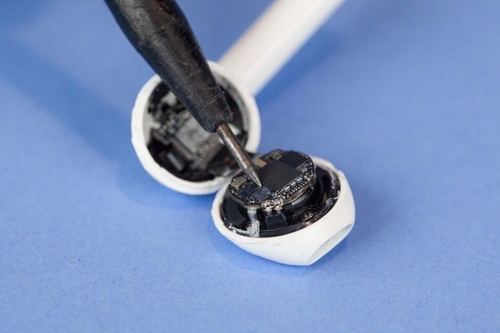
The truly wireless design of the AirPods is part of what makes them look so sleek, but it also means that each pod has to hold all the components needed for them to function independently of each other. Because of this and their already slim design, there is almost no empty space inside the AirPods.
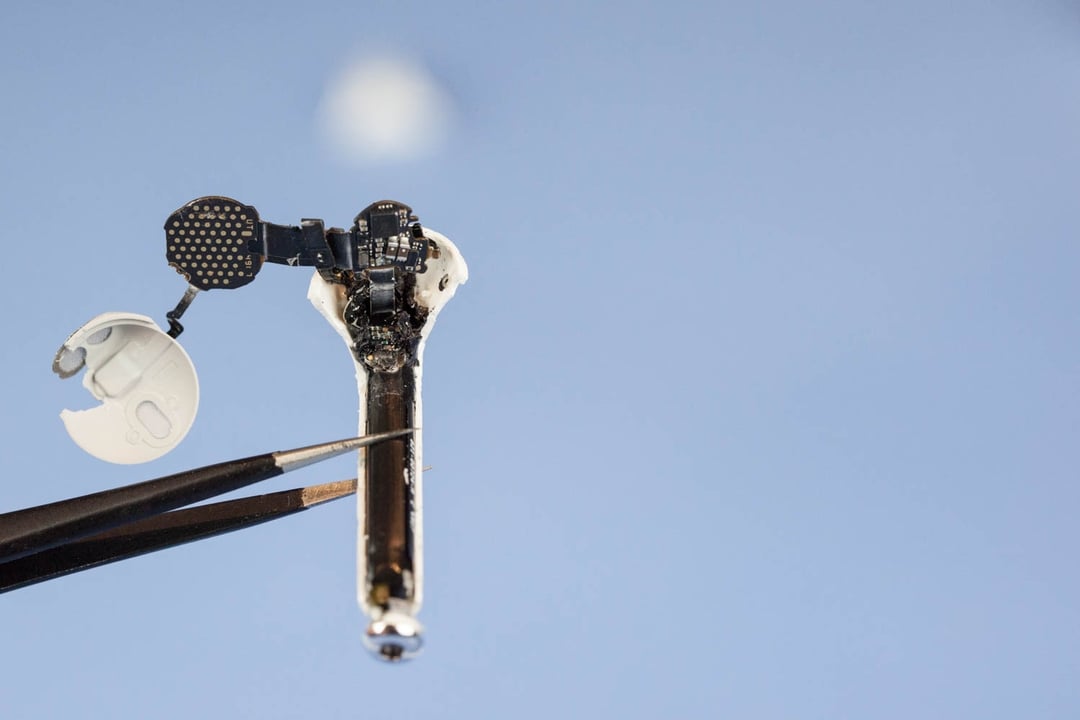
Two small PCBs that are stacked on top of each other and the speaker driver take up most of the space in the upper portion of the pod. Everything is connected by flex cables, except for the driver, which is glued and soldered directly to one of the PCBs, so no space is needed to house or assemble electrical connectors. Instead, the flex cables are folded and pressed flat against the inner walls of the pod, so that they take up a minimal amount of room.
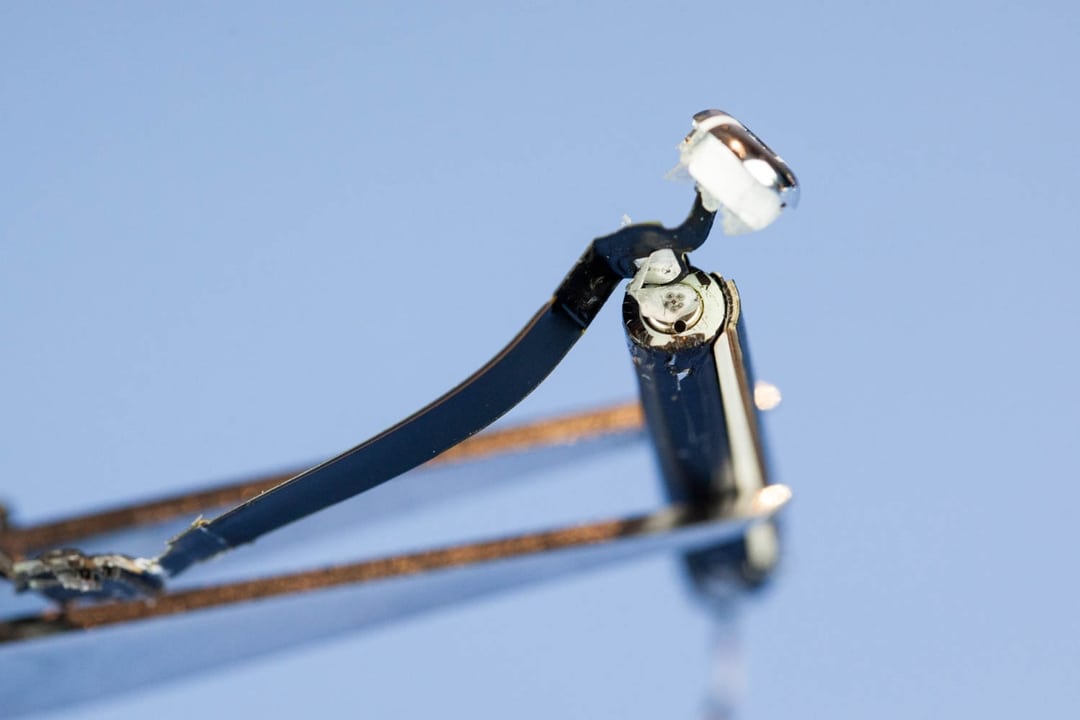
Interestingly, even though everything is so small and densely packed in the Airpods, they have a slightly larger speaker driver than the Pixel Buds do. A bigger driver usually makes for better sound, and while in this case, the difference is small enough that it may not be audible, it still speaks to how efficiently the Airpods are packed.
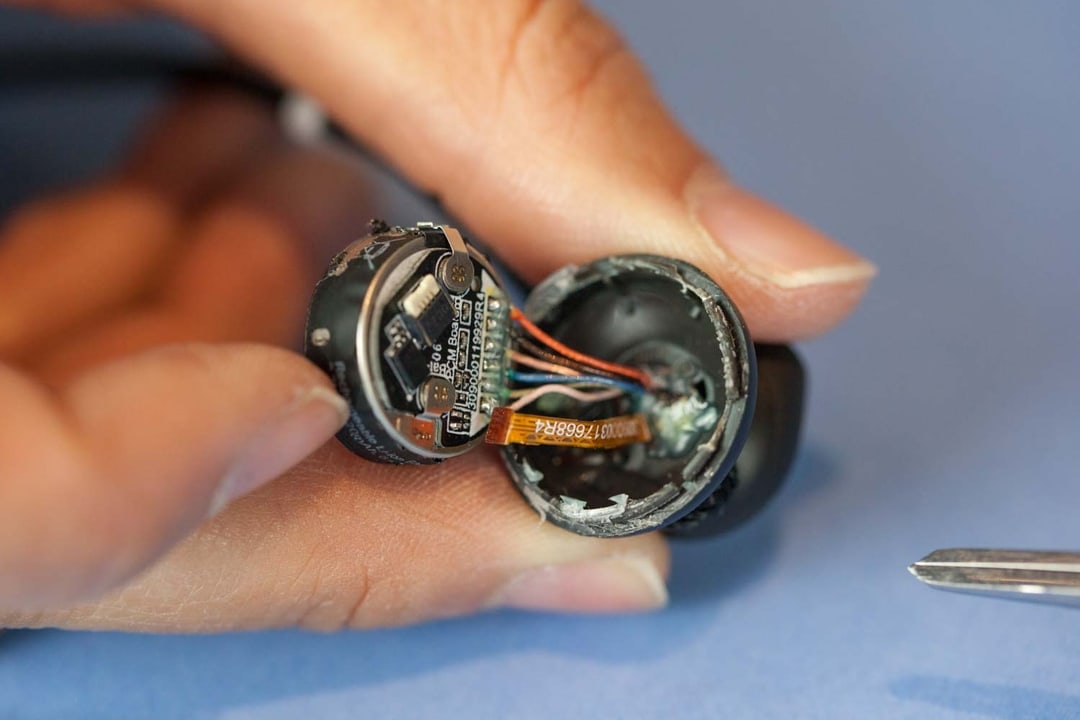
The Pixel Buds try to make the most of their space by having the left side dedicated to holding the battery, while the right side holds the processing PCB and antenna. This not only allows them to avoid doubling up on components (there’s no need for two battery management systems if there’s only one battery), but also leaves more contiguous space for each subsystem.
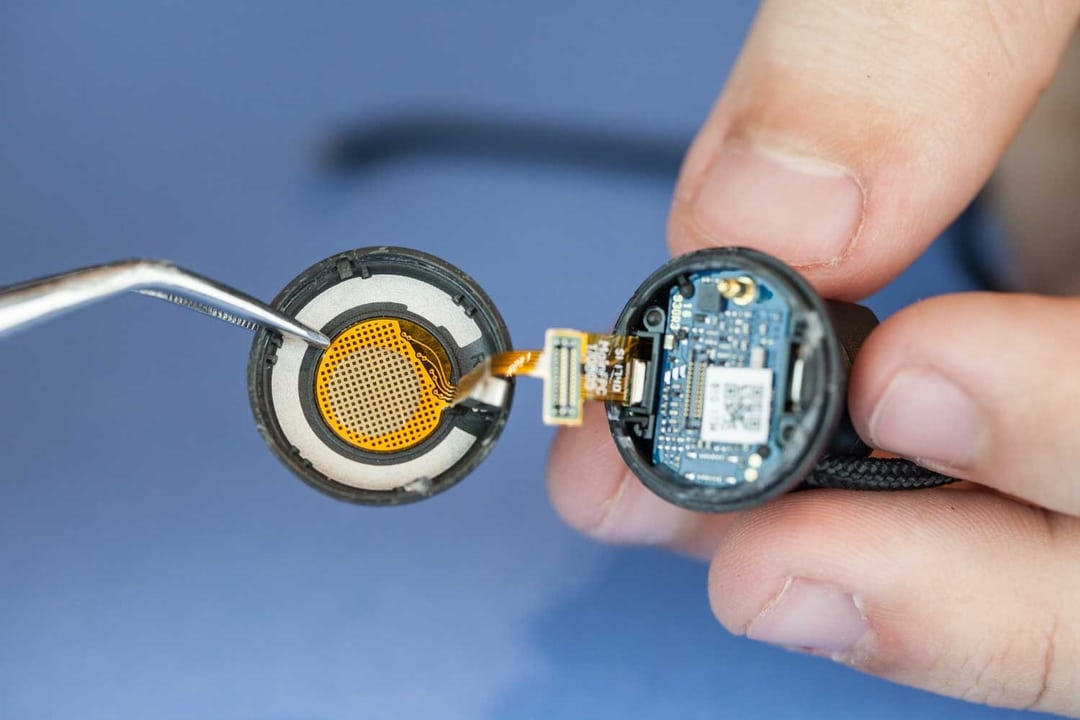
A wall in the middle of the central part of the buds separates the speaker drivers from the main PCB. This takes up space and requires passing a flex cable through a thin slot to connect all the electronics but allows for the electronics to be packed in from both sides. In the speaker half of the buds, the magnetic part of the speaker driver is transfer molded inside a plastic casing, to which the speaker diaphragm is glued. The drive presses into the central part of the bud and held in place by the inner ear cap.
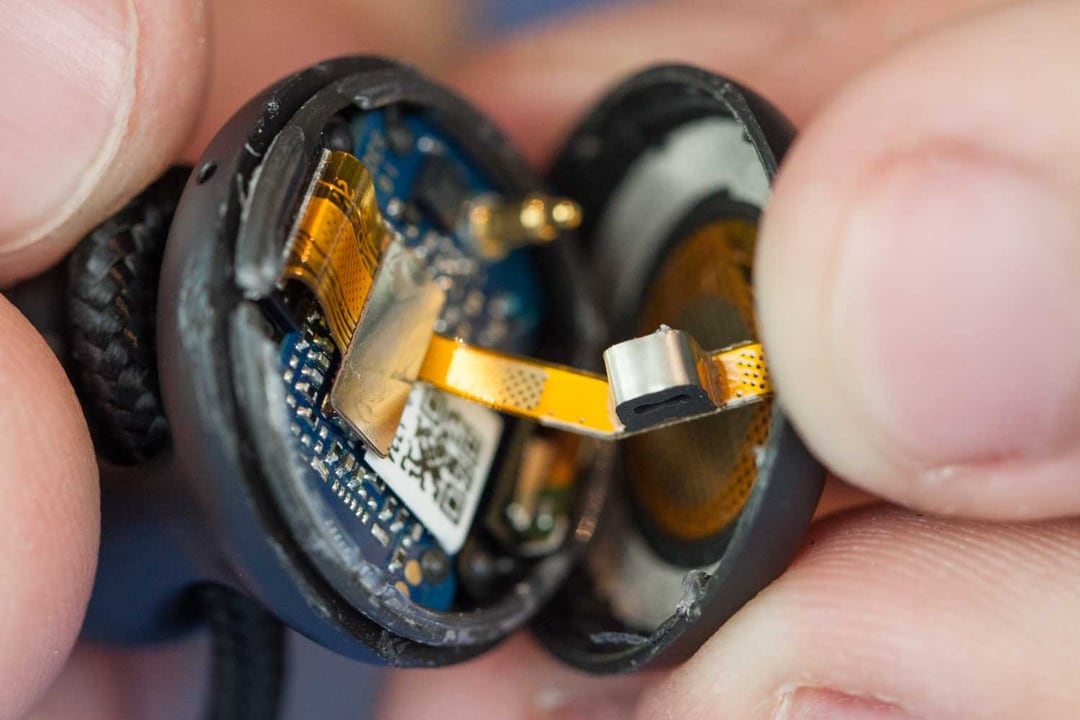
In the right bud, the pressure of the outer cap is actually used to make two electrical connections. The Bluetooth antenna is bonded to the inside of the outer cap, and when it is assembled, the antenna pushes onto a conductive pin sticking out of the main PCB. The pressure from the outer cap is also used to connect the capacitive sensor found in the cap, by using a foam block to push the sensor’s flex cable connector into place.
Main Takeaways
This teardown shows the pros and cons of the different routes Google and Apple took to solve the same problem. The AirPods and Pixel Buds are each meant to be worn in a specific manner, and the design choices made for each product cue the wearer to use the product in a certain way. Since the AirPods mirror the familiar design of Apple’s wired earbuds, it was fairly obvious how they were meant to be worn, but Google’s Pixel Buds included a few helpful design elements and a few confusing ones.
It just goes to show that even when you guide users to engage with your product in the intended way, it still has to be comfortable to use, in order for them to accept it (and not try to cut it in half).
On the inside, each pair of headphones represents each end of the continuum between ease of assembly and packing efficiency. The Pixel Buds have multiple features to aid assembly, and even have some unused space inside them. This makes them look big compared to the AirPods, even with the space saved by their asymmetric design.
The AirPods, in turn, owe their slim footprint, in part, to a much more complex assembly process. By removing connectors and twisting flex cables instead, almost all the internal space is filled, but getting everything to fit and stay that way must take a lot more precision and time.
The real takeaway, though, is that neither approach is better than the other. In order to make an electronic accessory that is like a piece of jewelry, Apple had to prioritize form factor and aesthetics. Google, on the other hand, made something more focused on function and features than on a slick shape. The end result of both is a capable product.
